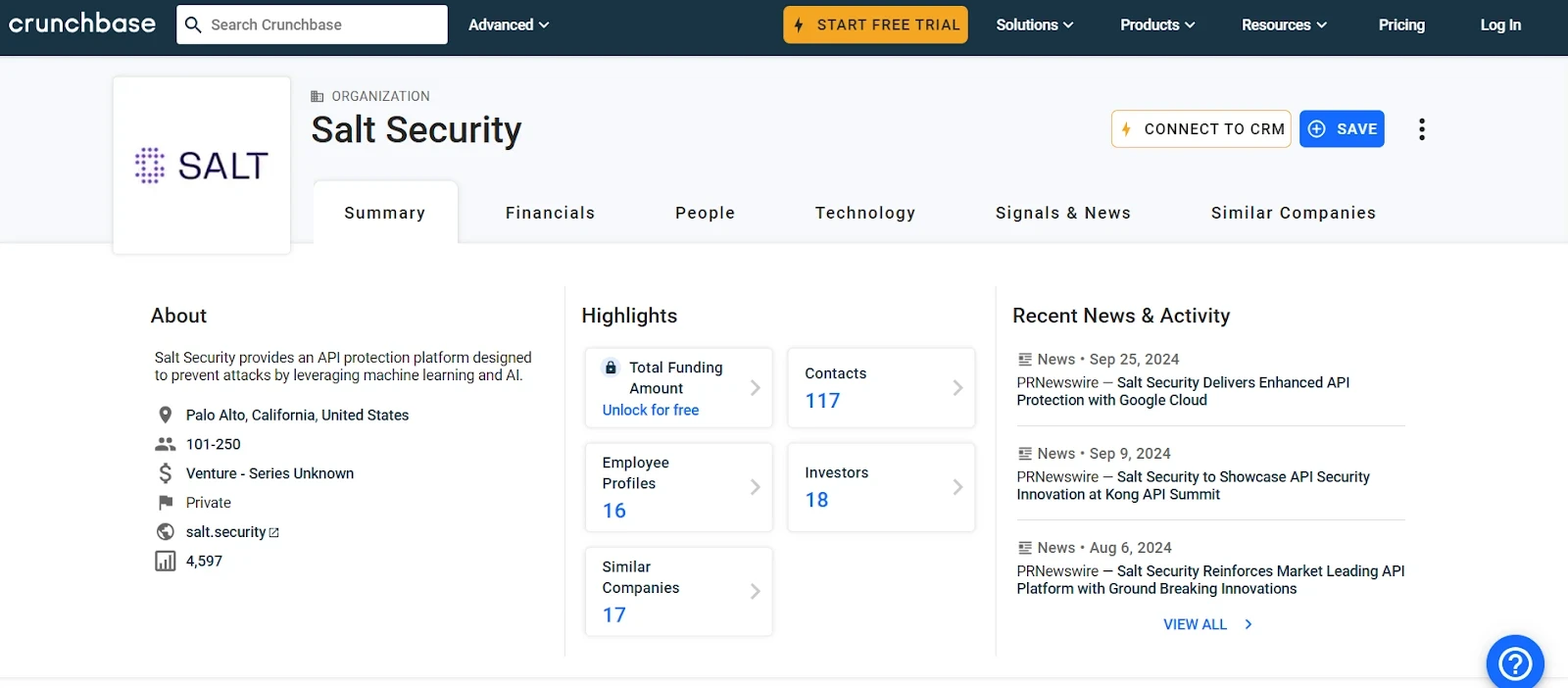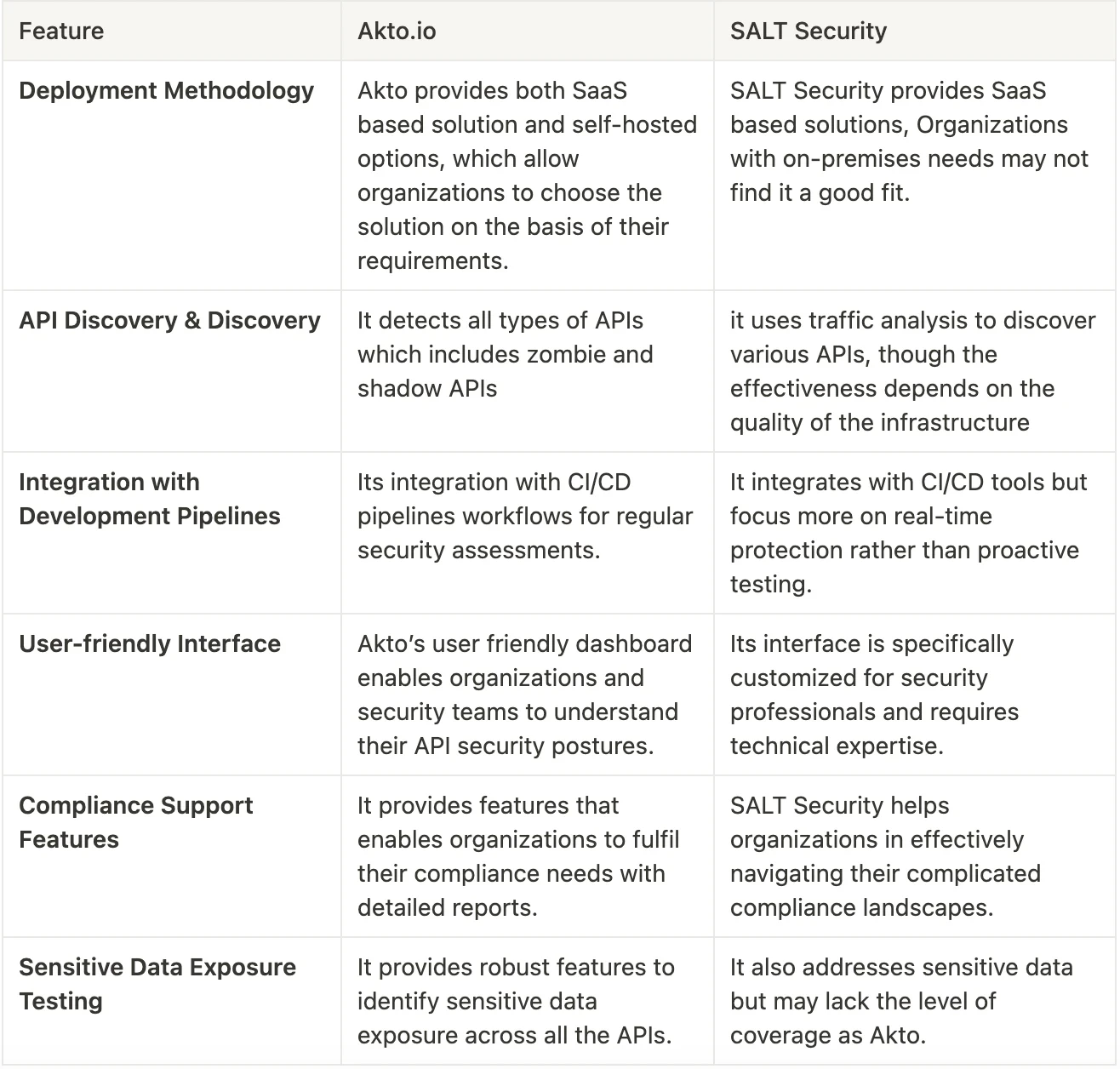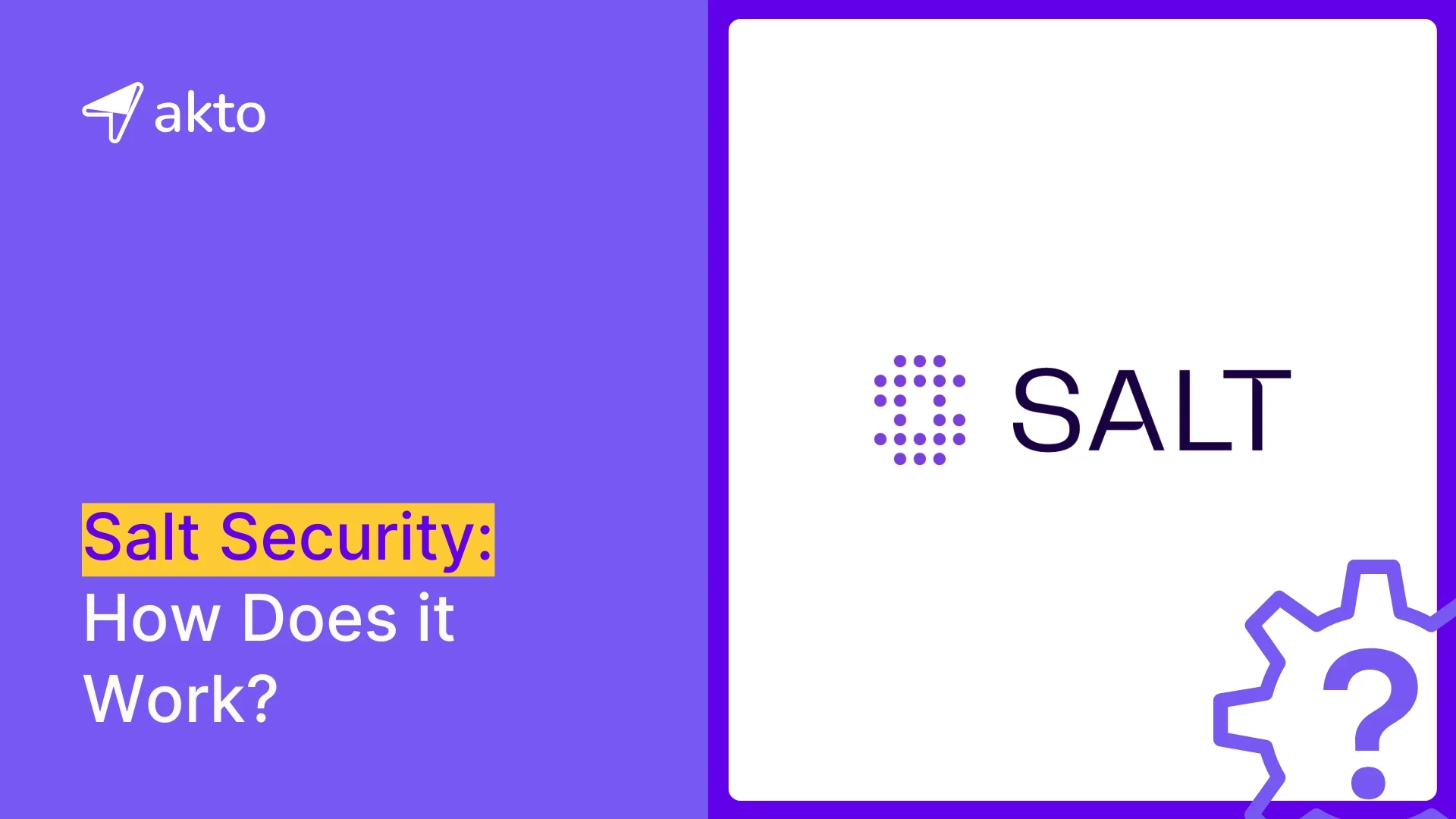Salt API Security is a platform that protects the APIs, which are the core of every modern application. Its patented API protection service detects and prevents API attacks by combining time-tested ML/AI and cloud-scale big data. This platform facilitates real-time analysis and regularly monitors API discovery and attack prevention insights across numerous APIs and users.
What is Salt Security?
The Salt Security company offers the API Protection Platform enabling organizations to detect the potential risks and security weaknesses in the APIs before malicious actors exploit them, including those in the OWASP API Security Top 10.
The API Context Engine (ACE) architecture in the Salt Security platform provides an evaluation process in the pre-production of APIs, explores the different APIs, and minimizes attacks on them. It also offers in-depth insights, allowing the development teams to secure the APIs in the organization network. Organizations can also avoid service disruption, data exfiltration, and account takeovers by utilizing runtime protection.
Salt Security's Approach to API Security
Salt Security adapts an innovative and comprehensive approach to API security, resolving challenges posed by modern APIs that can potentially become attack vectors. Let’s discuss the key elements of Salt AI-driven strategy:
AI and Machine Learning Integration
Salt Security provides advanced artificial intelligence (AI) and machine learning to fetch large amounts of data from APIs. This helps security teams to detect vulnerabilities and suspicious behavior across the API ecosystem.
Contextual Threat Detection
Salt Security correlates the activities of various API calls, Salt Security helps security teams differentiate between possible threats and legitimate users. This analysis enables the detection of low and slow attacks during the development phase.
Full Lifecycle Protection
It provides security to APIs throughout their lifecycle, from development to deployment and runtime. This ensures continuous monitoring and protection of APIs against potential threats and breaches.
Comprehensive API Discovery
This platform automatically detects all the organizational APIs, including Zombie API and Shadow API. This feature allows organizations and security teams to manage their API inventory effectively and identify any exposed crucial data.
Advantages
Real-Time Identification: Salt Security can identify various security weaknesses in real time based on the organization’s network traffic.
Integration Options: Salt Security provides many integration points for network logs and can identify sensitive data using these logs.
Posture Management: The security teams can strengthen the running security assessments by saving the searches as posture rules.
Disadvantages
• Header-Based Alerts: The alerts are based on HTTP headers rather than payloads, which can reduce the effectiveness of threat identification.
• Noisy Risk Scoring: Risk scoring is basic and can lead to a lot of noise, complicating prioritization.
• High Costs: The security teams can use traffic mirroring for identification, which can increase the logging costs, making it an expensive option for organizations.
Challenges and Limitations of SALT Security
Reactive Approach to Security Testing
The platform primarily maintains a focus on the evaluation of traffic in the organization’s network and on continuous monitoring to detect security weaknesses. With this, it limits the platform’s capability to identify different security weaknesses, which may ignore unmonitored APIs, leading to security risks.
Compliance Challenges
SALT Security offers various features, including predefined posture rules, but lacks a straightforward view of the organization’s API across services. This disadvantage makes it challenging for organizations to asses compliance gaps and quickly prioritize security efforts.
Limited Actionability of Findings
SALT Security findings are often not easily actionable. It can detect security weaknesses but gives very little direct support to security teams and organizations to address these issues. The security engineers have to manually interpret alerts into fixes as they lack step-by-step instructions, making it time consuming and prone to errors.
Integration Complexity
The integration of security frameworks into SALT Security can be complicated and resource-intensive. Organizations may face issues in aligning SALT’s capabilities with the security tools, which may lead to delays in implementation.
Dependency on Accurate Data
SALT Security relies heavily on accurate and complete data to increase the effectiveness in threat detection and analysis. Incorrect data can generate false positives or missed security weaknesses. The security teams need to be sure about their API inventory updation for SALT to function more effectively.
User Training Requirements
Security teams and developers require proper training to use SALT Security more effectively. Organizations may face challenges in using their full potential without proper knowledge of the platform’s features and functionalities, leading to inadequate security outcomes.
Salt Security Pricing
Salt Security which offers flexible and customized pricing for its API Protection Platform, which it tailors to each organization's needs. The pricing depends on various factors, including the amount of the API deployment, the complex ecosystem of the API, and the other features that security teams may need, such as API discovery, real-time threat identification, and attack prevention capabilities.
Contact Salt Security directly for the best and most up-to-date information regarding pricing. To learn more about this or for a custom quote, please visit Salt Security's website and contact them with your sales inquiries.
Salt Security Crunchbase
Salt Security founded the company in 2016 and has its headquarters in Palo Alto, California. It specializes in securing APIs, which are the main requirements of modern web, mobile, and third-party applications.
Its platform secures sensitive data and services flowing through APIs that are extremely important in accelerating digital transformation. With its approach, Salt Security helps businesses manage and mitigate the growing risks associated with API usage, which accounts for over 80% of web traffic today.

Source:
Salt Security’s rapid growth has gained significant attention, especially after its Series D funding round in 2022, which brought its valuation to $1.4 billion. The company has raised $271 million in funding, with major investors such as Sequoia Capital and Advent International supporting it.
Akto.io: API Security Approach
Akto is an API Security platform that offers robust protection to the APIs against threats and security weaknesses. It integrates with advanced AI technologies and provides features like testing vulnerabilities and misconfigurations.
Core Security Features of Akto.io
Real-Time Monitoring: Regular monitoring of API traffic identifies new security weaknesses and changes in configurations as they occur, enabling a robust security posture.
Support for Multiple API Types: Akto supports different APIs such as SOAP, JSON-RPC, REST, GraphQL, and gRPC, which makes it a good option for different application infrastructures.
API Inventory Management: It regularly manages an inventory of APIs, including shadow and zombie APIs, which provides security teams with insights into their APIs.
Comprehensive Vulnerability Testing: It tests the APIs against OWASP Top 10 and HackerOne Top 10 security weaknesses, which include Broken Object Authorization (BOLA) and cross-site scripting. This allows security teams to detect security flaws at the earliest.
User-Friendly Interface: Akto’s user-friendly dashboard is an easy-to-use platform for security teams and organizations, offering actionable insights into API security.
SALT Security vs. Akto.io: A Detailed Comparison
Let’s compare SALT Security and Akto.io, identifying their key features, capabilities, and unique approaches to application security testing.

Final Thoughts
Salt Security is a platform that provides the feature of real-time analysis and detects API discovery and attack prevention insights of various APIs and users. It detects all possible risks and security weaknesses in the APIs before the attack, which includes the OWASP API Security Top 10.
Salt Security makes an innovative approach to API security, including AI and Machine Learning integration, contextual threat detection, complete lifecycle protection, and comprehensive API discovery.
Akto is a platform that offers features like a developer-friendly ecosystem and simple deployments, providing a good spot for small organizations that want cheap security without complicated configurations. Book a demo today to learn how Akto can protect the API ecosystem and enhance the organization’s security.
Want to learn more?
Subscribe to Akto's educational emails for essential insights on protecting your API ecosystem.

